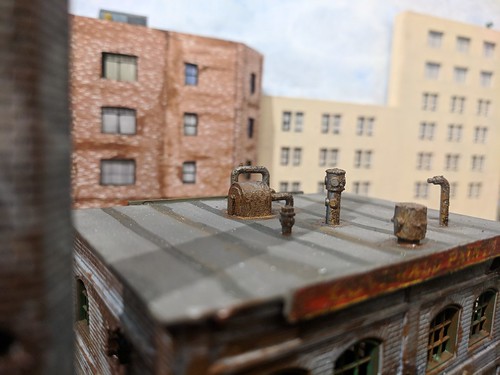To all the subscribers and visitors:
THANK YOU for your continued support and encouragement which keeps me going to add more and more to Wrightsville Port and thrive to make it a truly enjoyable little model train layout. I know that there hasn't been any update in this blog for over 20 months and I apologize for that. What happened is that I have taken on other miniature projects in the mean time that kept me distracted from completing Wrightsville Port. However, I am back with the layout now and there are some exciting new developments that will be coming in next few months.
I am however consolidating all content management efforts to maximize time to do the actual model making work, hence going forward even items that are related to Wrightsville Port will be maintained in my Trains and Dioramas blog (link below). Most likely, there will not be any further post on this blog, so if you are a subscriber or visiting this blog, please feel free to follow my new consolidated blog which will not only include all the activities about Wrightsville Port, but a lot of other miniature projects as well. You can find quite a few of them if you visit right now.
Here are the places to find my work and a way to stay connected:
Trains and Dioramas Blog
I will continue to add Wrightsville Port and other miniature project related items here regularly. Please subscribe. The Website also contains video tutorials and other contents which will be constantly updated. Feel free to look around and stay engaged.
YouTube Channel
A variety of video content starting from How-to Videos/Instructions, Layout Tours and even Prototype Railroad and Travel related content - all focusing on Railroading or Miniatures. Please Subscribe.
In addition, you can stay connected via Facebook or Instagram as well by liking and following.
Well, thank you again for all your support and encouragement, hope to see you on the other side soon.
Happy Railroading,
Kaustav and Mouli
P.S. Before we go, Wrightsville Port moved to its 6th home in 2 cities that are 1000 miles apart in a little more than 7+ years of its existence! Here is the album that shows the latest photos of the layout:
THANK YOU for your continued support and encouragement which keeps me going to add more and more to Wrightsville Port and thrive to make it a truly enjoyable little model train layout. I know that there hasn't been any update in this blog for over 20 months and I apologize for that. What happened is that I have taken on other miniature projects in the mean time that kept me distracted from completing Wrightsville Port. However, I am back with the layout now and there are some exciting new developments that will be coming in next few months.
I am however consolidating all content management efforts to maximize time to do the actual model making work, hence going forward even items that are related to Wrightsville Port will be maintained in my Trains and Dioramas blog (link below). Most likely, there will not be any further post on this blog, so if you are a subscriber or visiting this blog, please feel free to follow my new consolidated blog which will not only include all the activities about Wrightsville Port, but a lot of other miniature projects as well. You can find quite a few of them if you visit right now.
Here are the places to find my work and a way to stay connected:
Trains and Dioramas Blog
I will continue to add Wrightsville Port and other miniature project related items here regularly. Please subscribe. The Website also contains video tutorials and other contents which will be constantly updated. Feel free to look around and stay engaged.
YouTube Channel
A variety of video content starting from How-to Videos/Instructions, Layout Tours and even Prototype Railroad and Travel related content - all focusing on Railroading or Miniatures. Please Subscribe.
In addition, you can stay connected via Facebook or Instagram as well by liking and following.
Well, thank you again for all your support and encouragement, hope to see you on the other side soon.
Happy Railroading,
Kaustav and Mouli
P.S. Before we go, Wrightsville Port moved to its 6th home in 2 cities that are 1000 miles apart in a little more than 7+ years of its existence! Here is the album that shows the latest photos of the layout:



















































